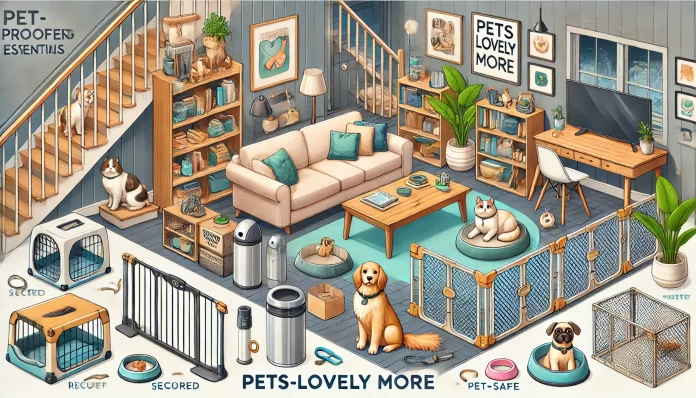Welcoming a furry friend into your home is an exciting time! However, it also requires some pet-proofing to keep your home and pet safe. Here are the key areas to focus on and essential tips for pet-proofing your home.
Securing Potential Hazards
Pets, especially curious kittens and puppies, can get into all sorts of dangerous situations. Make sure to secure or remove:
- Toxic houseplants – Lilies, sago palms, azaleas, and others can be lethal if ingested. Replace with pet-safe options.
- Small objects or choking hazards – Secure buttons, pins, paper clips, etc. in containers. Avoid pet toys with small, removable parts.
- Strings, ribbons, rubber bands – These can cause lethal intestinal issues if swallowed. Keep secured.
- Human medications, recreational substances – Lock away safely, well out of reach. Consider child-proof locks.
- Alcohol, household cleaners – Secure locked cabinets for these. A curious lick can be harmful.
- Electric cords – Tape down or hide cords. Cats and ferrets especially may chew these.
- Trash cans – Use pet-proof covered cans or containers, as rodents and messy eaters can spread garbage.
Securing outlets and avoiding tippable furniture are also key for active pets prone to climbing and jumping. Considering pet-proofing tape as well.
Providing Mental Stimulation
Bored pets tend to get into trouble! Prevent destructive behaviors and provide mental stimulation by:
- Having a variety of interactive toys rotated to keep pet’s interest
- Food puzzle toys and dispensers for mental challenge
- A comfortable, permitted scratching surface for cats
- Access to windows with view of outdoor activity
- Providing species-appropriate hiding and climbing spaces
- Ensuring owner has dedicated playtime with pets daily
Having “occupying snacks” like dental chews or food puzzle toys can also keep pets engaged for hours.

Pet-Proofing Living Areas
Take a room-by-room approach to identify problem areas based on pets’ habits and access:
Entryways
- Place durable mats by exterior doors to wipe muddy paws
- Consider a bench, crate or gate to contain overexcited greeters
Kitchen
- Use baby gates to limit pet’s access when unsupervised
- Secure trash cans in latched cabinets
- Keep pets away during cooking and keep appliance cords secured
- Store pet food bags in chew-proof containers
Living & Family Rooms
- Cover or secure vulnerable furniture like leather sofas
- Use gates to limit access to home office spaces
- Ensure aquariums and pet cages are securely closed
Bedrooms & Bathrooms
- Use baby gates and keep doors closed to limit access
- Secure medications and grooming supplies in cabinets
- Cover waste bins; use caution with toilet lids
Laundry Rooms
- Keep laundry pods and supplies in high, latched cabinets
- Use a baby gate or keep door closed for safety
Garages & Basements
- Store all chemicals, fuels, tools in locked cabinets
- Check for gaps allowing outdoor rodents inside
- Cover exposed insulation, wires
- Check pets cannot access doors to unsafe outdoor areas
Remaining vigilant about picking up household items and keeping cabinets secured goes a long ways towards preventing incidents! Replace guitar strings, rubber bands, paper clips for office supplies like binder clips less tempting to cats and dogs.
Providing Proper ID and Containment
Essential pet-proofing also means ensuring your home supports secure containment and proper pet ID.
- ID tag – Engraved collar tag with pet’s name and owner’s current phone number at minimum
- Microchip – Permanent ID chip registered with up-to-date contact info
And ensure fencing, gates and access to doors makes unsupervised outdoor access impossible:
- Fenced backyards with secure latches and dig-proof fencing
- Baby gates for indoor staircases and room division
- Secured windows, screens and door locks
Having proper ID and containment measures prevents lost pets and accidental escapes leading to dangerous situations.
Conclusion
Pet-proofing is an essential process for any home welcoming a new furry family member. By securing hazards, providing mental stimulation, containing access, and having ID measures in place, owners can create safe, enriched environments for pets to thrive while protecting their home. Be sure to re-asses as pets age and face new challenges. Diligence in early puppy and kitten stages leads to safe habits as they reach more destructive adolescent phases. With some planning and preparedness, owners can look forward to many happy, healthy years with beloved companion animals.
For more pet-proofing tips, check out these additional resources:
- ASPCA Pet-Proofing Guide
- Best Safe Houseplants for Pets – The Spruce Pets
- Introducing Baby Gate for Pets – American Kennel Club

